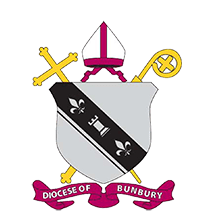Leschenault
For over 130 years, from 1850 until the mid 1980s, the Leschenault area was part of the parish of Bunbury and sometimes Dardanup.
Until the 1970s Mass was celebrated in a small building at the top of the Leschenault estuary, along Cathedral Avenue. The building was originally built as a Roman Catholic provisional school in 1875. The priests came from Bunbury to celebrate the Mass in the chapel until about 1916, and then from Dardanup for the next 18 years, until taken over again by Bunbury in 1934.
Some of the priests to visit and celebrate the Mass in those days were Dean Martelli, Father Deleaney and in the 1930s Father O’Grady and his horse Wee Bobby are fondly remembered.
Max Rodgers, now of Brunswick, was an “altar boy” at the church for 24 years. Max continued to serve at Mass into the 1960s, well past his boyhood, because “no one else knew the Latin.” Originally constructed of jarrah slabs and a shingle roof, the building was consecrated by Archbishop Redmond Prendiville in 1941 and became known as The Church of St. John Vianney. By the 1960s the Catholic population near the church was such that it was no longer practical to use the building for Masses. It fell into disrepair and was finally demolished in the 1970s.
Due to the revival of Masses at Eaton and Australind in the 1980s, the present site was purchased with substantial bequests from pioneering families such as Paddy Rodgers, Johnny Dunne and the Travers family, the sale of the land where the original church stood and also a private donation.
When Leschenault Parish was formed in 1986, a decision was made to build a school before a church because the area and the parish were growing. A Catholic school and Mass centre were built and Fr Pat Rooney was installed as Parish Priest.
Planning for a new church began in 1989 with the construction beginning in 1991. The new building is a steel structure, externally clad in limestone, with a metal roof and internal Oregon ceiling. Donnybrook stone tiles are laid in the entry and sanctuary floor. Jarrah seating and altar furniture round off the Australian bush flavour.
The new church of “Christ The Living Vine” was blessed and consecrated by Bishop Peter Quinn, Bishop of Bunbury on 10 May 1992.
Patch Story
Christ the Living Vine Church.
A digital image of the Church taken from the southern side. This is the natural bushland side of the Church.
The photo was taken with a Mavoca Camera and transferred onto a vinyl sheet. The church is a very roomy and inviting area with a large gathering place for social interation.
Border – The border is obviously the representation of the Living Vine. Lenny Hines embroidered it in different shades of green.
